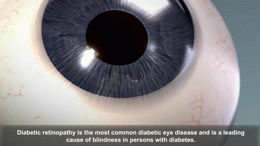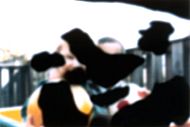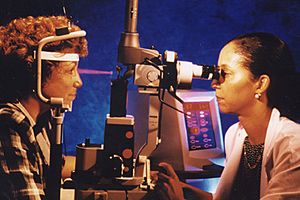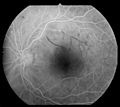Diabetic retinopathy facts for kids
Diabetic retinopathy is a common eye problem caused by diabetes. It damages the retinas in both eyes, which are the light-sensing parts at the back of your eyes. This can lead to blurry vision and, in serious cases, even blindness.
This condition affects many people who have had diabetes for a long time. However, if it's found early and treated correctly, most severe cases can be prevented.
Contents
How Does Diabetic Retinopathy Affect Your Eyes?
Diabetic retinopathy often doesn't show any signs at first. But as it gets worse, new, weak blood vessels can grow at the back of your eye. This is called proliferative diabetic retinopathy (PDR).
Early Warning Signs
These new blood vessels can bleed into your eye, which is called an ocular hemorrhage. This bleeding can make your vision blurry. The first time this happens, it might not be very bad. You might just see a few small spots floating in your vision. These spots often disappear after a few hours.
Later Problems
Sometimes, after a few days or weeks, a lot more blood can leak. This makes your vision much blurrier. In very serious cases, you might only be able to tell light from dark in that eye. It can take a long time for the blood to clear from inside the eye, sometimes even years. In some cases, it might not clear at all. These larger bleeds often happen more than once, sometimes while you are sleeping.
When a doctor examines the back of your eye, they might see spots or small areas of bleeding. High blood sugar levels can also cause the natural lens in your eye to swell. This swelling can make you temporarily nearsighted, meaning you have trouble seeing things far away. A common sign of this swelling is that distant objects look blurry, but close-up vision remains good.
How Doctors Treat Diabetic Retinopathy
Managing Your Health
In the early stages of diabetic retinopathy, you usually don't need special eye treatment. However, it's very important to control your blood sugar, blood pressure, and cholesterol levels. This helps stop the eye problem from getting worse.
Laser Surgery
Laser surgery is a common treatment for diabetic retinopathy. It uses a special laser to help your eyes.
Scatter Laser Treatment
This treatment is used for proliferative retinopathy, where abnormal blood vessels grow. The doctor uses a laser to make many tiny burns in the retina, away from the central vision area. These burns help the abnormal blood vessels shrink. You might need two or more sessions. After this treatment, your side vision, color vision, and night vision might be a little less clear.
Scatter laser treatment works best before the new, weak blood vessels start to bleed. But sometimes, it can still help even after bleeding has begun.
Focal Laser Treatment
Focal laser treatment is used for macular edema, which is swelling in the central part of your retina (the macula). The doctor places small laser burns around the macula where blood vessels are leaking. This helps to seal off the leaking vessels and reduce fluid buildup. This surgery is usually done in one session, but more treatments might be needed. If both eyes have macular edema, doctors usually treat one eye at a time, a few weeks apart.
Focal laser treatment helps to keep your vision stable and lowers the chance of losing vision by 50 percent. In some cases, if vision has been lost, it might even get better.
Eye Surgery (Vitrectomy)
Vitrectomy is a surgery to remove the vitreous humor. This is the clear, jelly-like fluid that fills the inside of your eyeball and helps it keep its shape. This surgery is done when severe scar tissue forms on the retina due to proliferative retinopathy. It's also used if new blood vessels keep growing even after laser treatments.
Medicine for Your Eyes
New research shows that certain medicines can help treat diabetic macular edema. Drugs like Lucentis, Avastin, or Aylea can be injected into the eye. These medicines help reduce fluid leakage and stop new blood vessels from growing in the retina. They can lead to better vision compared to laser treatment alone.
Images for kids
See also
 In Spanish: Retinopatía diabética para niños
In Spanish: Retinopatía diabética para niños







